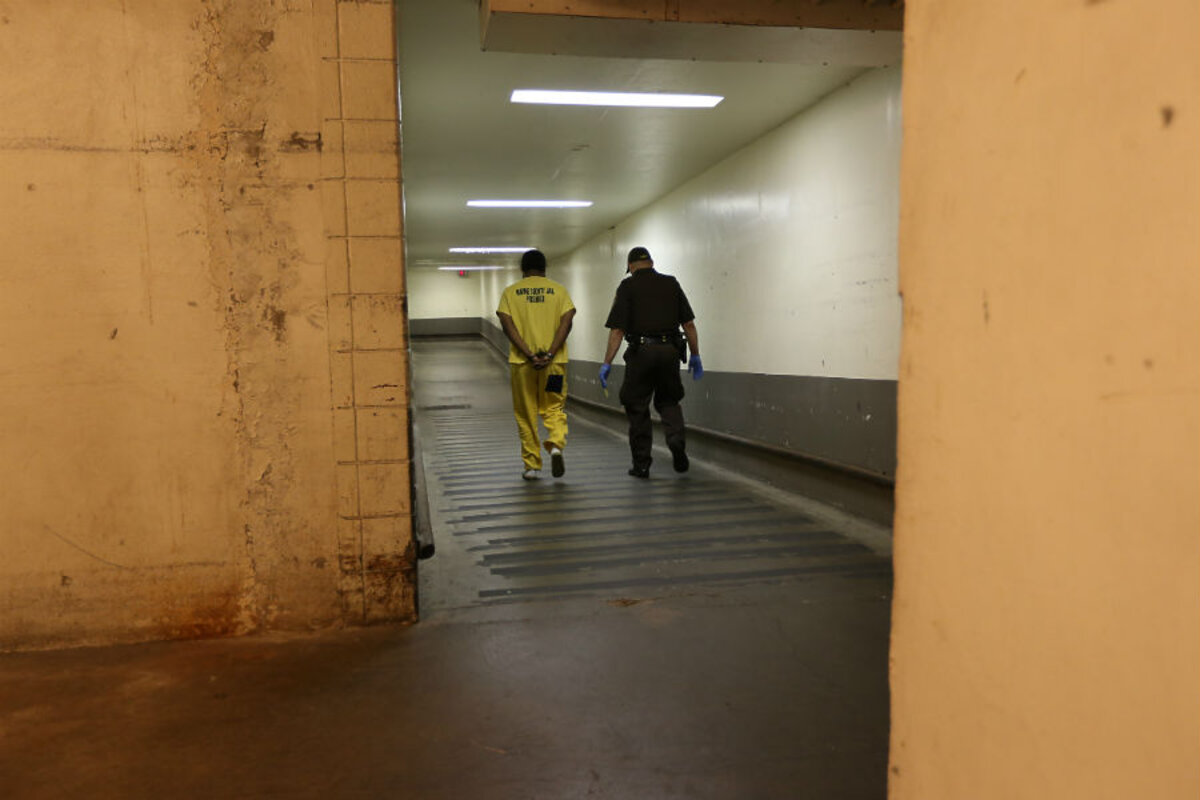Early release for 6,000 federal prisoners: A risk to public safety?
Loading...
Willie Best did some crazy stuff in his life, before being sentenced to nearly a decade in federal prison. The jury that convicted him in 2008 heard that the D.C. drug dealer was found by cops in a stolen car clutching an assault rifle, after taking a potshot at a nemesis.
But Mr. Best is joining some 6,000 federal prisoners whose sentences are being cut short under new federal sentencing guidelines and whose release will be soon. Best told the Associated Press that he’s a new man: “I came in one way. I’m coming out another.”
The US Sentencing Commission changed its guidelines for drug convictions last year, and they apply retroactively. Prisoners can go before a judge to have their case reviewed for a sentence reduction, and at the least, it’s a motley bunch of characters. Some – including Best – don’t fit the innocent “nonviolent drug offender” label that marijuana activists have long said characterizes the primary victims of the war on drugs.
Indeed, as a total of some 40,000 federal prisoners are likely to have their drug sentences reduced in the next few years, some critics are concerned that the program could create public safety risks.
Until now, broader debate over the new guidelines has been muted, partly due to a lag between when the guideline changes were made – a year ago – and when the early releases begin. But the first batch of releases, set for a few weeks from now, is likely to give rise to a larger conversation about the purported benefits of unlocking prison doors ahead of schedule for people convicted on drug charges.
“Six thousand people could be a scary thing,” Mary Price, general counsel of Families Against Mandatory Minimums, . “Or it could be a signal that we as a nation are serious about rethinking our approach to crime and punishment.”
The commission has changed sentencing guidelines before, but the changes in question are considered sweeping because they apply to all drug types. With the new guidelines, sentences are reduced by an average of two years, or in many cases, by less than a year, according to AP.
A federal judge must determine whether a prisoner is eligible for an early release. More than 2,500 prisoners have been denied a change, according to a .
Earlier this year, for example, a judge in the District of Columbia chastised prosecutors for recommending leniency for a pair of cocaine traffickers whom the judge deemed violent and calculating. Their early release request was denied.
At the same time, however, there’s building, though hardly definitive, research that suggests such early release programs don’t pose a public danger – or at least that risks don’t necessarily outweigh the fiscal and humanitarian benefits of going easier on drug offenders.
After California voters in 2012 amended the state’s tough “three strikes” sentencing law, the state in the ensuing year released some 1,000 prisoners who were eligible under the new rules. A by the Stanford Three Strikes Project and the NAACP Legal Defense and Educational Fund found that the released prisoners had a 2 percent recidivism rate, compared with the average of 16 percent for state prisoners.
Critics were quick to say the study was flawed: The average length of time out of prison was four months – hardly enough, critics said, to properly measure whether the ex-cons might re-offend.
Meanwhile, there are rumblings among some conservatives about the fact that the early releases begin as dozens of US cities have seen spikes in their violent crime and murder rates this year.
But for the most part, conservatives have, in a rare flash of bipartisanship, supported moves to ease up on harsh mandatory minimum sentences, which have largely fueled the US prison growth since the 1990s. Mandatory minimum policies came into vogue as a way to battle high violent crime rates in the 1980s, but they’ve increasingly been seen as out of place in a country where the overall crime rate has been steadily falling since 1992. Congress did not block the new sentencing guidelines.
“There are positives to locking people up, but there are negatives, too, that we’re beginning to address,” John Malcolm, director of the Edwin Meese III Center for Legal and Judicial Studies at the conservative Heritage Foundation in Washington, told the Monitor this summer.
“I don’t think anybody is being stupid about” releasing possibly dangerous individuals, Mr. Malcolm continues. “But the big question is, once someone has been incarcerated for two years, do they need to be there for five years? If prison is designed to send somebody a message, after you’ve sent them that message and have given them skills they need, and you determine that they’re not going to pose a threat, perhaps it’s time to free up a prison cell for someone who richly deserves it.”
Such a shift in thinking on punishment largely corresponds to changing attitudes about marijuana. Four states have legalized marijuana for recreational use, and about 20 states now have medical marijuana dispensaries, which contradict the US Drug Enforcement Administration’s determination that marijuana has no proven medical benefits.
On Sept. 1, a Missouri prisoner named Jeff Mizanskey made headlines after he walked free some 20 years after being sentenced to life in prison for his role in a marijuana deal. Democratic Gov. Jay Nixon had commuted the life sentence and the Missouri parole board, after hearing testimony about Mr. Mizanskey’s plans upon reentering society, released him. Public support for Mizanskey, a low-key carpenter with a grown son, centered on the unfairness of the sentence in an era when views about marijuana have changed.
Not all those eligible for release under the new guidelines may be equally sympathetic figures, one former prisoner notes.
“Man, there are some broken people who committed a technically nonviolent offense, but that’s because they pled down a gun charge,” Kevin Ring, a former Washington lobbyist who spent 13 months in federal prison for his role in the Jack Abramoff lobbying and bribery scandal, said in a Monitor interview this summer. “I hate it when we romanticize the prison population, like it’s Bill Gates that we’re about to set free. Some are really the lowest of the low.”
But, he adds, “others have families, and it’s clear they could contribute more” outside prison than inside.





